The Land Rover Defender is not my sort of vehicle. It's big. It's heavy. It doesn't handle remotely like a sports car. I dig it anyway. Why? See below. Of course, like any vehicle the Defender has its downsides. We'll cover those too.
As a serious off-road vehicle, the Defender has few direct competitors. Of this few--the Jeep Wrangler, recently resurrected Ford Bronco, and redesigned-for-2019 Mercedes G-Wagen--I've only driven the first, and that one a few years ago when only a 285-horsepower engine was available. While I'll attempt a bit of a comparison, you're encouraged to perform your own.
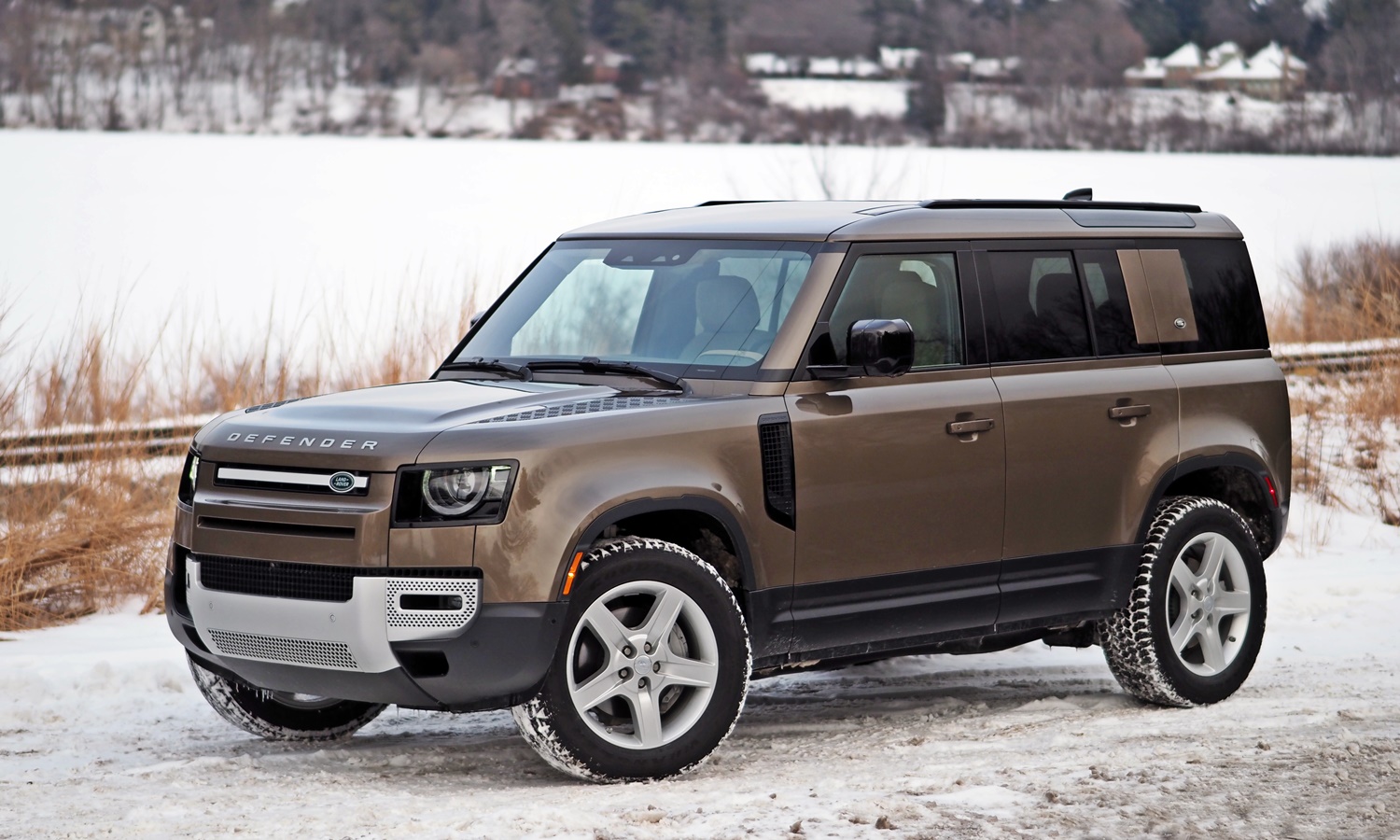
Due to its proportions and large wheels the Defender can appear smaller than it is (fairly large). more Defender photos
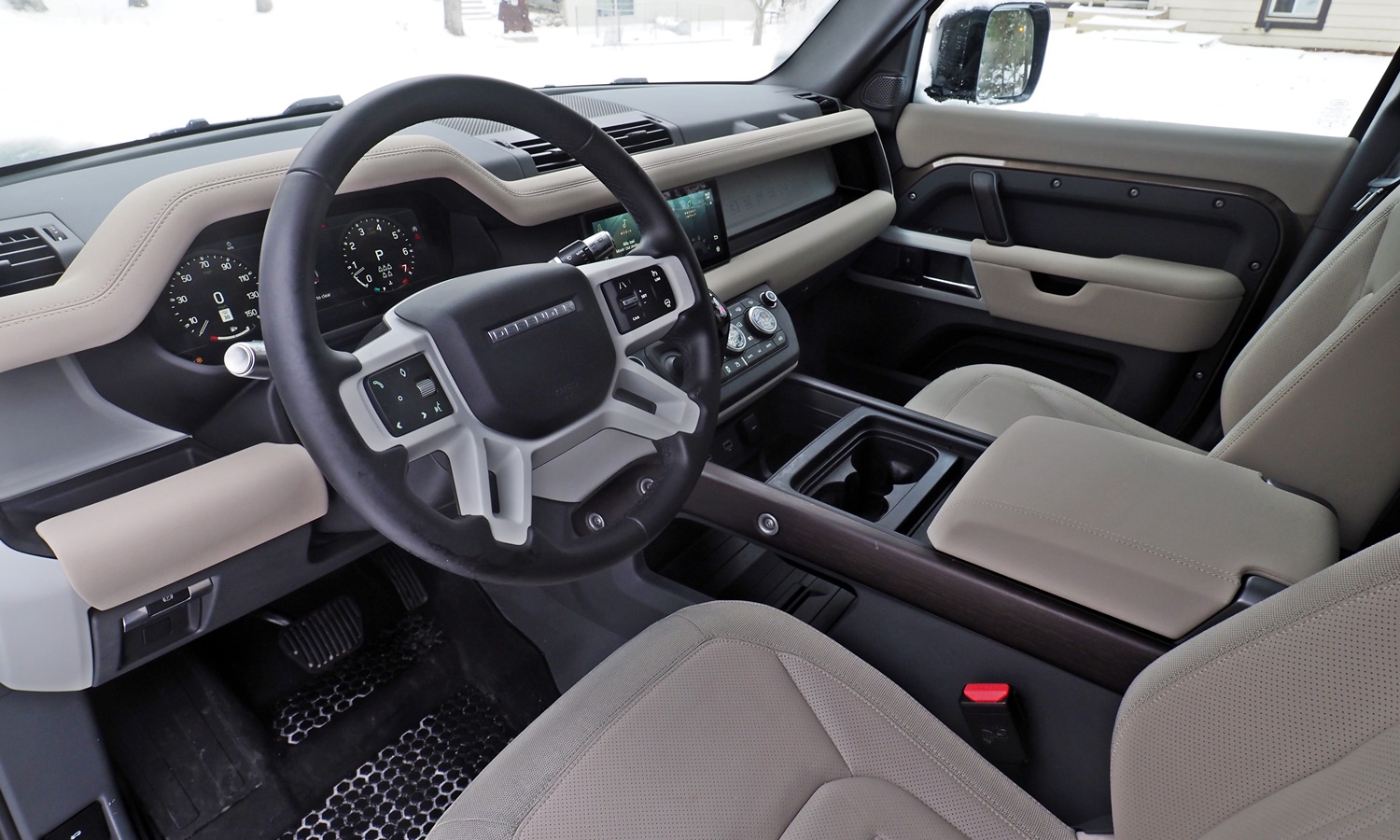
Quite a few hard surfaces, but the Defender's interior comes across as rugged rather than cheap.
| |
Compared to the Wrangler |
| Exterior styling |
 Better
Worse
Better
Worse
|
The reasons I'm enthused about the new Defender can be summed up in two words: good design. Not just a design that looks good and that looks like nothing else on the road, but one that embodies the essence of the model's history and that serves various functions, while avoiding overdesign.
First, that history. Most auto makers are lucky to possess a single iconic model. Land Rover, though small as auto makers go, has two: the Defender--famous for treks through Africa--and the Range Rover--famous for treks through Chelsea and Beverly Hills. The latter has been redesigned three times, yet has maintained a clear resemblance to the 1969 original. The former (known simply as the "Land Rover" when there were no other Land Rover models) retained the same general appearance for even longer, from 1947 through 2016. Over this span Land Rover updated its most rugged SUV at least three times, but never fully redesigned it.
Once Land Rover had decided on a full redesign, what should they do? Ignore tradition, and do something entirely new? Or replicate the look of the original as much as possible while updating all of the bits under the skin? The latter would have been the safest option, and has been the route taken by Jeep and Mercedes. The former would have been foolhardy. When you've got an icon, you want to maintain visual links to the original. Ultimately, Land Rover opted to fully update the appearance of the Defender along with its underpinnings, but to retain the square, rugged, hyper-functional essence of the original.
With the resulting design, Land Rover has succeeded on every front. The new exterior is chock full of details, but these all come together to form a coherent whole where none looks out of place. The front end manages to appear powerful and distinctive without a huge menacing "look at me!" grille or other cartoonish elements. The Defender, confident of its strength and abilities, feels no need to pose as a monster or weapon.
Most of the exterior details are subtle; this is one of those designs that can initially appear simple, but the longer you study it the more you'll notice. You might even notice that the new Defender isn't nearly as square as clever design makes it appear. The front corners and the roof actually have quite a bit of curve to them.
Perhaps most important of all: people know what they're looking at--a tool for serious off-road driving--and they like it.
| Interior styling |
 Better
Worse
Better
Worse
|
With the interior of the new Defender, Land Rover has sought to retain the utilitarian flavor of the original yet provide the upscale finishes people expect in a fairly expensive vehicle. They've largely succeeded at this challenging combination. Materials are clearly better than you'll find in a Ford or Jeep, yet look and feel rugged. Metal in the exterior color peeks through on the doors. The trim on the doors and console is attached with exposed torx-head screws. The face of the instrument panel is actually the magnesium structural cross-car beam powder-coated in one of three finishes but otherwise bare. This beam has an integrated grab handle at each end--useful when getting into such a tall vehicle.
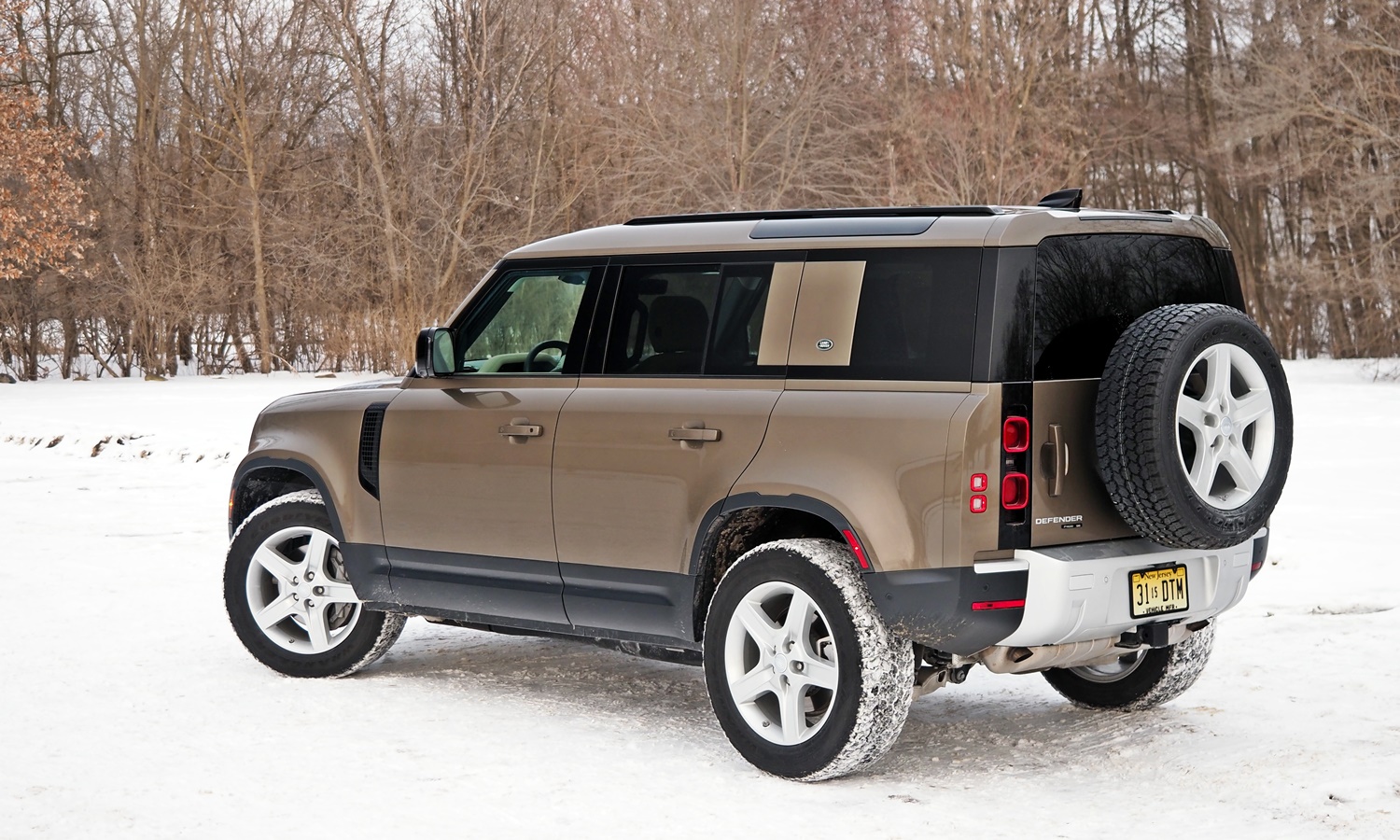
Quite a bit going on, yet the design comes across as clean.
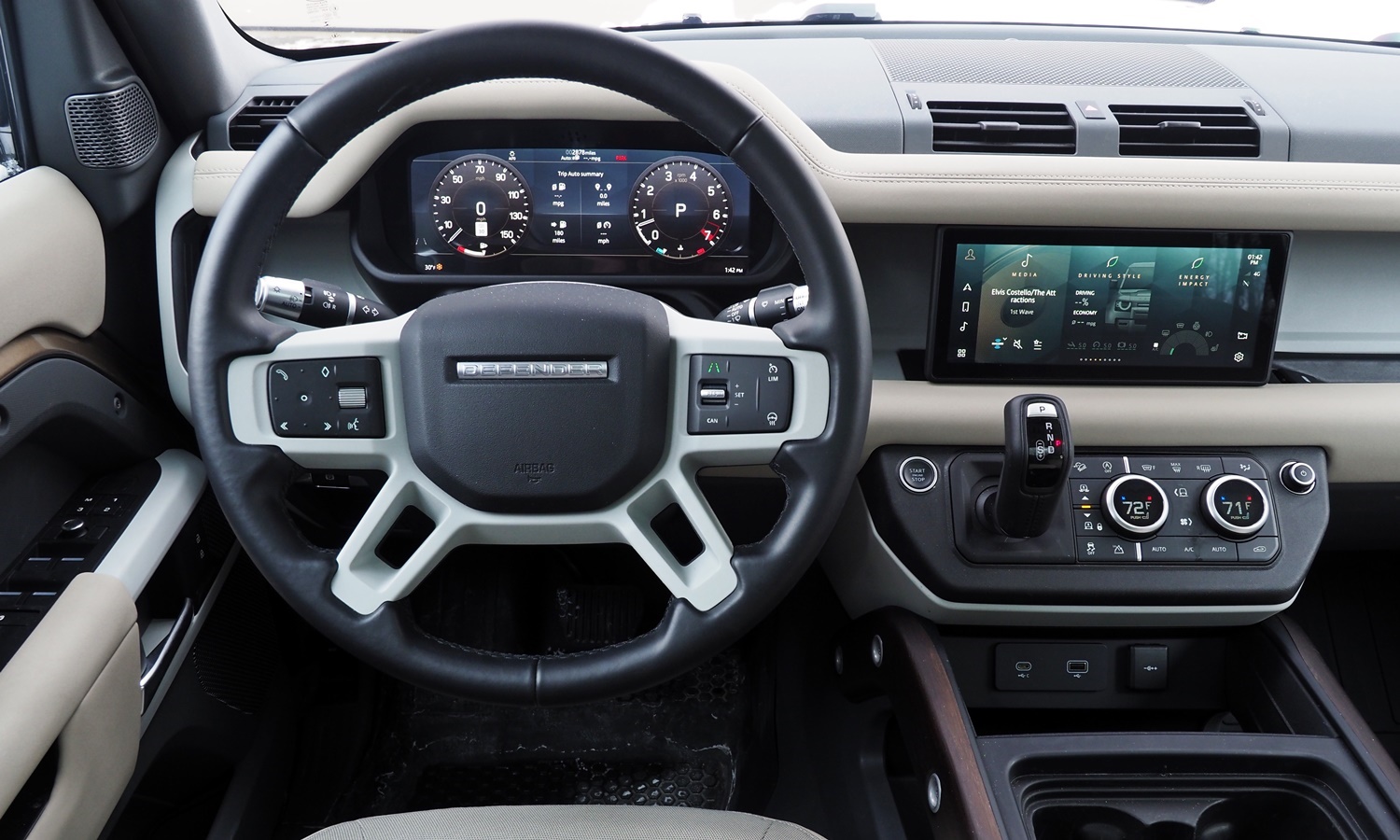
Purposeful interior design. The light gray bits are power-coated magnesium.
| Off-road capability |
 Better
Worse
Better
Worse
|
I cannot comment on the new Land Rover Defender's off-road capability from personal experience, as the most challenging terrain I drove it over was deep snow (which it and its tires managed easily). But the Defender is Land Rover's most capable vehicle and warrants comparison with other serious off-road vehicles.
The basic specs aren't promising. Unlike the Wrangler, Bronco, and G-Wagen, the Defender employs unitized rather than body-on-frame contruction. But its aluminum (rather than steel) unibody is exceptionally strong and stiff. Overhangs are short, for sharp approach and departure angles. Unlike the others, the new Defender also has an independent rear suspension. (In the interest of extreme off-road capability, the Jeep doesn't even have an independent front suspension.) But this suspension has been designed for exceptional ruggedness and articulation (if still less of these than a Wrangler Rubicon's rigid axles). A locking center differential is standard, while an active lockable rear differential is optional. Unlike on the others, a locking front differential is not available, but given the Defender's sophisticated multi-mode "terrain management" traction control system (which can apply the brakes to mimic a locked differential) one will rarely if ever be missed.
The Defender has been designed and engineered to drive up, down, or across 45-degree slopes--very steep. Or it can be driven through 35.4 inches of water--more than any of the others--with a camera-linked wade-sensing mode to assist with this feat. With the air suspension standard on the four-door at its highest setting, ground clearance is nearly a foot. Only over especially uneven terrain will one of the other hardcore SUVs enjoy an advantage over the Defender.
| Powertrain performance |
 Better
Worse
Better
Worse
|
Currently the Land Rover Defender can be powered with one of two engines, a 296-horsepower turbocharged 2.0-liter four-cylinder or a 395-horsepower mild-hybrid supercharged and turbocharged inline-six-cylinder. For 2022, a 518-horsepower supercharged V8 will also be offered. All are paired with a manually shiftable eight-speed automatic transmission.
I tested a Defender with the six-cylinder engine, and found it accelerates the 5,165-pound SUV with little apparent effort--impressive for a 3.0-liter. The 48-volt mild-hybrid system boosts low-rpm grunt in two ways: via a belt-linked starter-generator and by powering an electrically driven supercharger. At higher rpm an exhaust-driven twin-scroll turbocharger assumes responsibility for boost. More power in a vehicle of this size and type would make little rational sense. To my ear, the boosted inline six sounds somewhat like a diesel, which seems appropriate in a truck. But does it sound the same in Jaguars? I doubt it.
| Handling |
 Better
Worse
Better
Worse
|
I went back and forth on whether to include handling among the reasons to buy a Land Rover Defender. Compared to even a fairly large crossover (e.g. the Toyota Highlander Hybrid I tested the previous week), the Defender feels large and unwieldy and rides somewhat stiffly. But compared to other off-road-oriented SUVs, the Land Rover handles with significantly better precision and control. It might drive even better on pavement if a sport mode was provided. As it is, the steering feels moderately light at all speeds unless you go through the trouble to set up and select a custom driving mode. With these, you can specify one of three levels of steering effort.
During the week I drove the Defender snow often covered the roads. I found the SUV's handing to be quite intuitive on snow. Selecting snow mode helped maintain control by tweaking the throttle, traction control, and stability control.
| |
Compared to the Wrangler |
| Reliability & durability |
|
We don't have any reliability data on the new Land Rover Defender. But Jaguar Land Rover's past record has been so spotty and the new Defender is so packed with sophisticated systems that reliability cannot but be a concern. The air suspension standard on the four-door Defender is a likely problem area, as such systems have been a problem area on just about every European SUV that offers them.
| Controls and instruments |
 Better
Worse
Better
Worse
|
The controls of Jaguars and Land Rovers have a long history of idiosyncracy, and the new Defender continues this tradition. While I had figured out much of the functionality by the end of my week, the learning curve was steeper than most. Clever design doesn't always help; to minimize the number of physical controls the HVAC knobs do double and even triple duty. For those who take the time to learn all of the Defender's available functions and how to access them, though, the controls should work well, perhaps even very well. RTFM.
The controls in a Wrangler or a Bronco will be simplier and easier to use, but there's also much less they have to do as those vehicles include significantly fewer features.
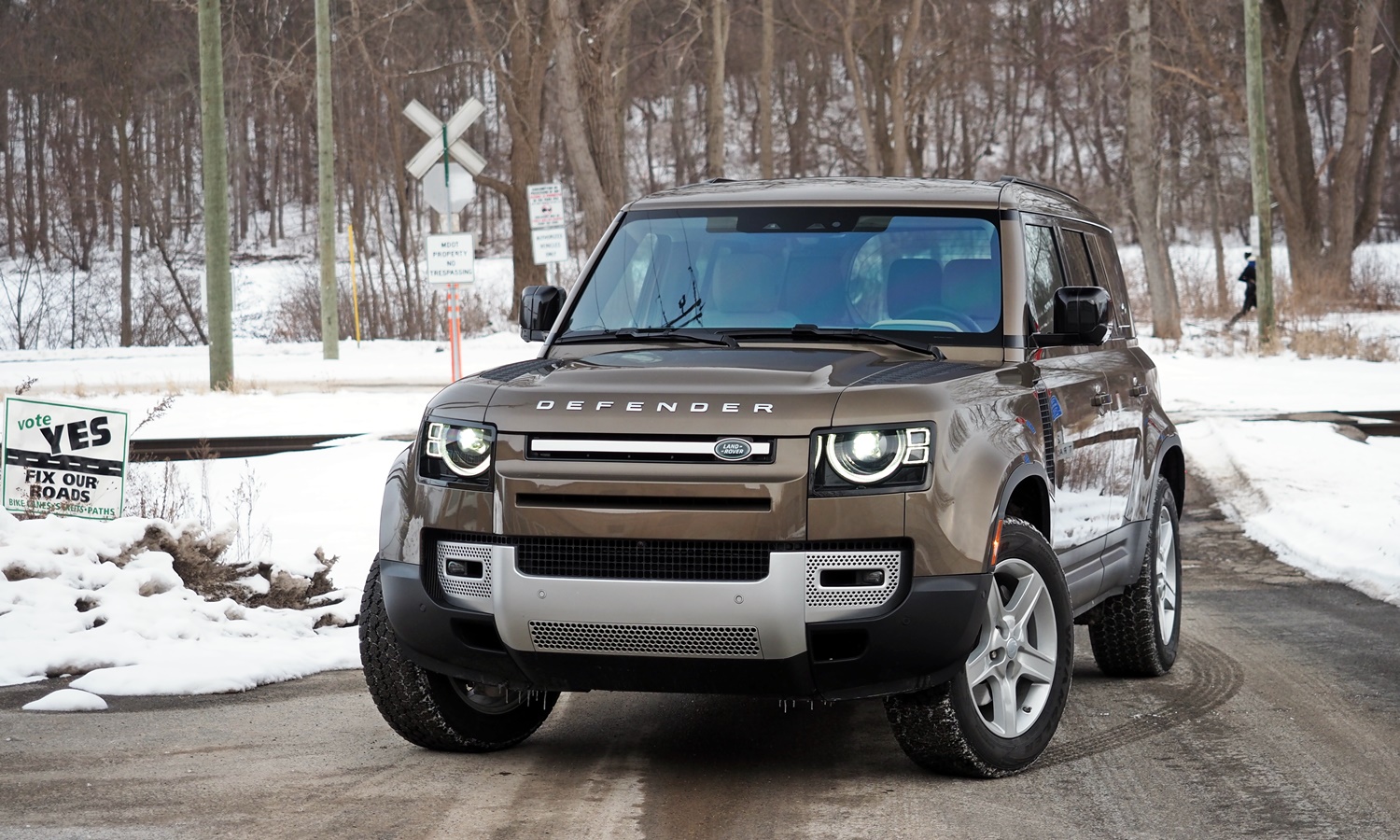
It is possible for a vehicle to appear purposeful without a huge grille.
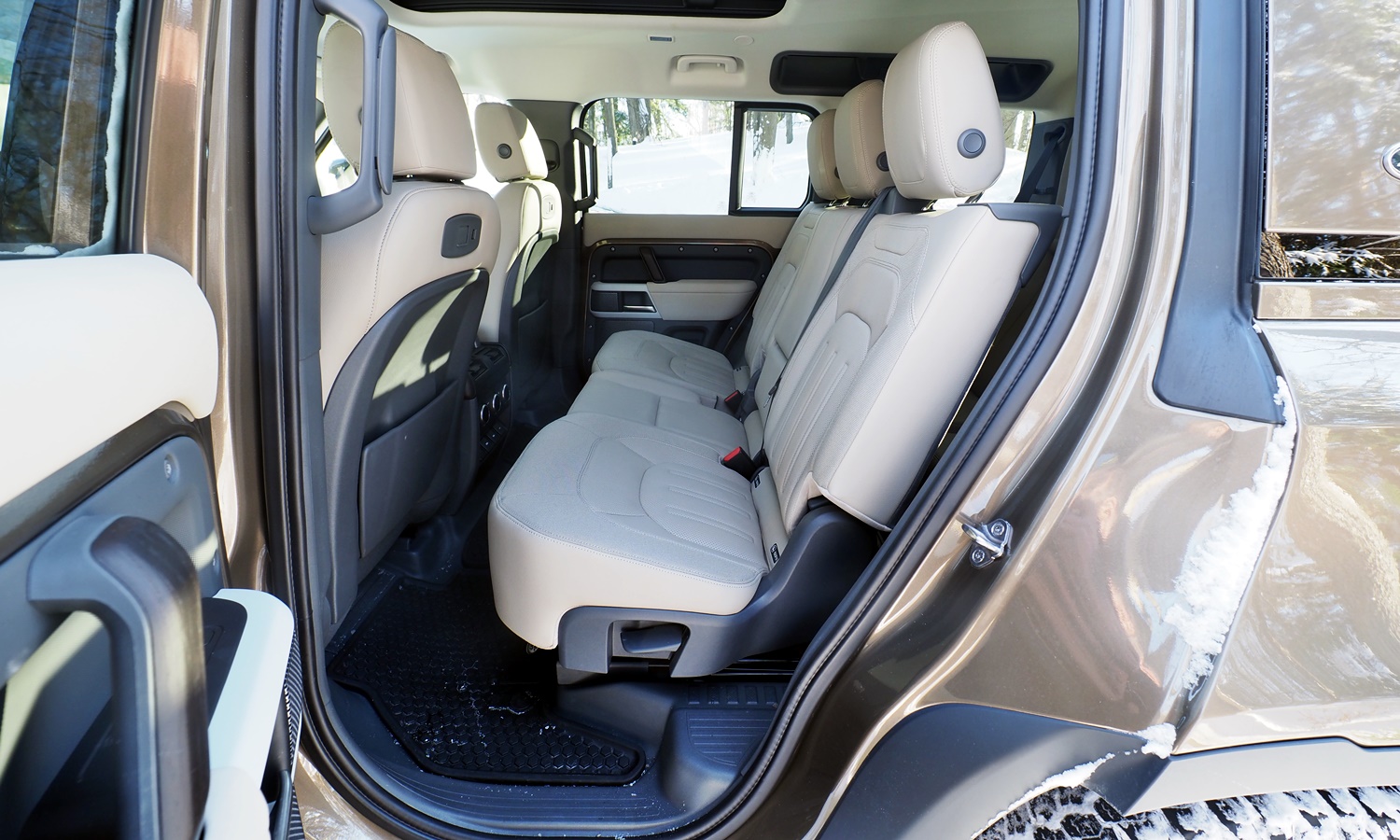
Comfortable height off floor, but marginal legroom if space must be made for third-row passengers.
| Rear seat room & comfort |
 Better
Worse
Better
Worse
|
As a two-row vehicle, the Defender provides plenty of room. But if you want to use the third-row seat (optional on the four-door), the second row folks will need to slide forward a few inches, such that both rear rows end up with marginal legroom.
This shouldn't come as much of a surprise. Ignore the 197.6-inch length on the spec sheet, as ten of these inches are taken up by the external spare. Without the spare, the Land Rover 110 is merely 187.4 inches long--insufficient for three spacious rows. Even with transverse powertrains, three-row crossovers tend to be as lengthy as the Defender with the spare included.
One good way to maximize space in a relatively stubby vehicle is to mount the seats high so legs angle downward rather than forward, and the Defender's second-row seat is comfortably high off the floor. The third-row seat is not. There is plenty of headroom back there, so space constraints didn't force a low seat. There must have been another reason, such as the amount of space available for the folding mechanism. You might think that the third-row seat is intended for only occasional use, but Land Rover has given it seat heaters and its own HVAC fan control.
All of this said, even a tight third row is better than none at all if you need to carry seven people. And none at all is what you can get in the Wrangler, Bronco, or G-Wagen.
If you only occasionally need to carry a sixth person, the Defender alone offers the option of a front center jump seat in place of the console. What's more, this option is offered in the shorter wheelbase two-door Defender as well as in the four-door.
A vast array of features are standard or optional on the Land Rover Defender. But if you want to be able to remove the roof and doors like you can on a Jeep Wrangler or Ford Bronco, well, you can't. This isn't that sort of hardcore off-roader.
| |
Compared to the Wrangler |
| Front seat support & comfort |
 Better
Worse
Better
Worse
|
The Land Rover Defender's front seats don't fit me very well. Specifically, I feel excessive pressure beneath my thighs, and tilt the seat further forward than I would otherwise to reduce this pressure. As with seat comfort in any car, your personal impressions may vary. Test drive one for as long as you can.
| Driving position & visibility |
 Better
Worse
Better
Worse
|
Classic Land Rovers had a commanding seating position and unusually tall windows. The windows in the Defender are more average in height, and outward visibility to the front and sides is consequently also about average for an SUV.
With all of the seats up, rearward visibility with a conventional mirror would be poor. But a camera-based rearview mirror is standard on the SE and up, and optional on the others.
A sophisticated camera system can aid visibility all around the vehicle when off-roading. In one mode the system even shows the terrain under the front tires and directly in front of the vehicle.
| Cargo capacity |
 Better
Worse
Better
Worse
|
Once you understand that the Land Rover Defender is only 187.4 inches long without its external spare, its cargo volume specs should come as no surprise. There's enough space behind the optional third row for a row of grocery bags, but luggage for more than a couple of people isn't fitting in the 10.7 cubic feet back there. Fold the third row, and you'll have 34 cubic feet to work with--five cubes less than in the Honda CR-V, a compact crossover. Folding the second row yields 69 cubic feet, well behind the CR-V but nearly even with the Jeep Wrangler. But wait, there's (possibly) more! Even when folded the third-row seat takes up ten cubic feet. Without this option, the Defender can fit 79 cubic feet--three more than the CR-V and one more than the Ford Bronco.
Hardcore SUVs aren't going to match crossovers in terms of cargo volume because their higher ground clearances and more rugged suspension systems raise the height of the load floor. The Defender's load floor is three feet off the ground--about a half-foot higher than the typical crossover--but this can be reduced by a couple of inches using a button in the cargo area that activates the air suspension.
Even more than the Wrangler or the Bronco, the Defender compensates for a high load floor with a tall body. With a height of 77.4 inchs, the Defender is about four inches taller than the Jeep and the Ford and nearly a foot taller than a CR-V. Are you wondering how you're going to load and unload the accessory roof rack? Land Rover also offers an accessory roof ladder.
EPA ratings of 17 mpg city and 22 mpg highway, though they would be poor for a compact crossover, are pretty good for a vehicle of the Land Rover Defender's size and weight, especially when you consider its performance. In my winter driving I observed trip computer averages around 16 mpg in town and around 20 on the highway.
| Price or payments |
 Better
Worse
Better
Worse
|
Pricing for the Defender 110 SE starts at $63,600. The tested Defender had nearly $12,000 in options. $75,440 might seem like a lot for a vehicle, but you can now spend more for a Jeep Wrangler. Given the Defender's sophisticated construction and features, its price seems reasonable.
If you do want to spend less, a base Defender 110 (with smaller steel wheels and higher profile tires better suited for off-roading) starts at $51,850. Don't need four doors? The two-door Defender 90 starts at $47,450. The Wrangler and Bronco start about $20,000 lower, but comparably equipping them will narrow this gap.
The new Land Rover Defender impressed me with good design in terms of both aesthetics and functionality. It's refreshing for such a hardcore SUV to appear so unaggressive, yet also so strong and competent, plus stylish and distinctive. Despite unitized contruction and a fully independent suspension, the new Defender remains highly capable off-road while out-handling other serious SUVs on the road. The doubly boosted six-cylinder engine impresses with its performance and doesn't horrify with its fuel economy. Even a moderately equipped example includes so many features that I couldn't explore or even discover them all in just a week. Downsides include potential reliability issues and controls that will take a while to learn. But, as with any vehicle that honestly communicates a high level of capability, if you think you think you might like owning a Land Rover Defender then you almost certainly will.
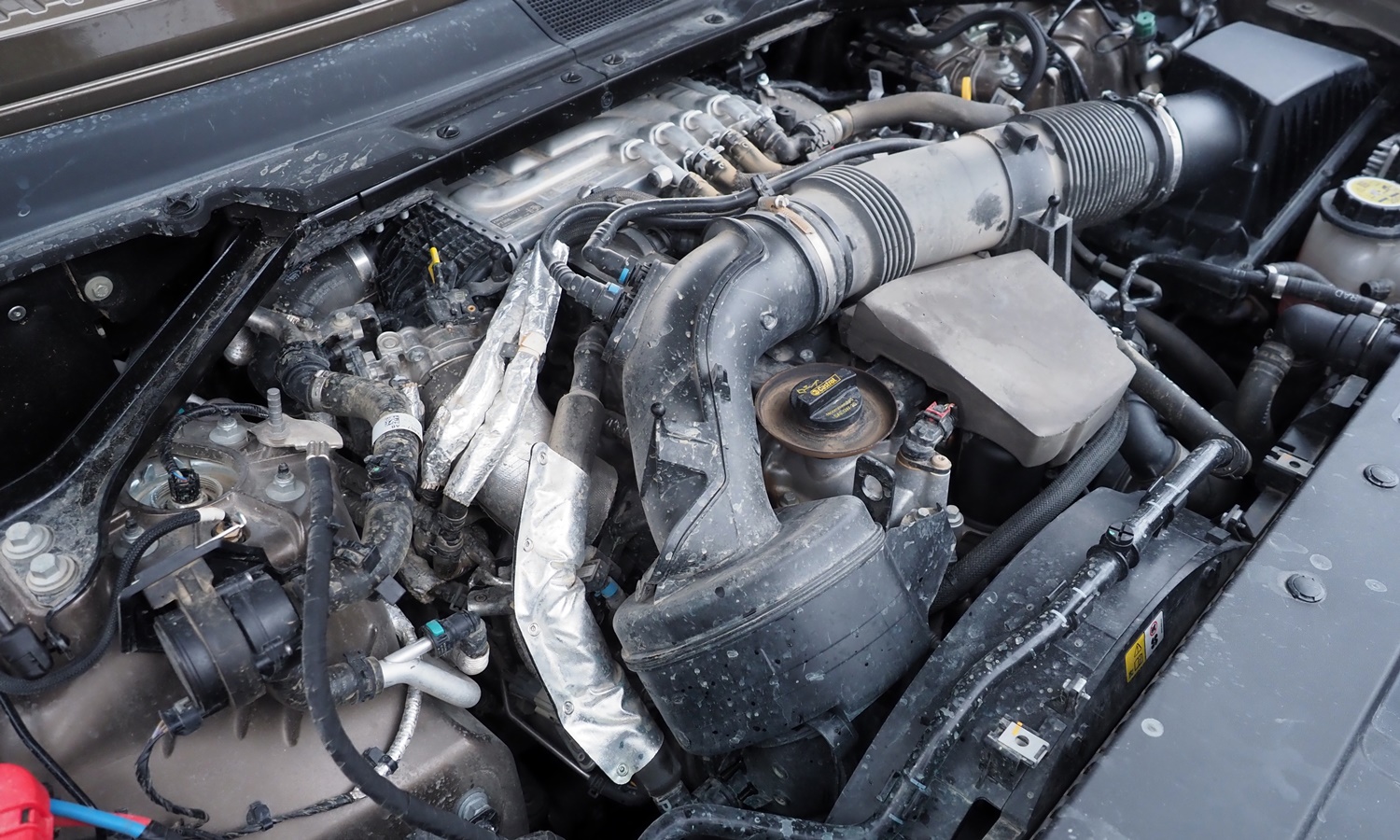
JLR's new inline six might not be much to look at, but otherwise it rates well.
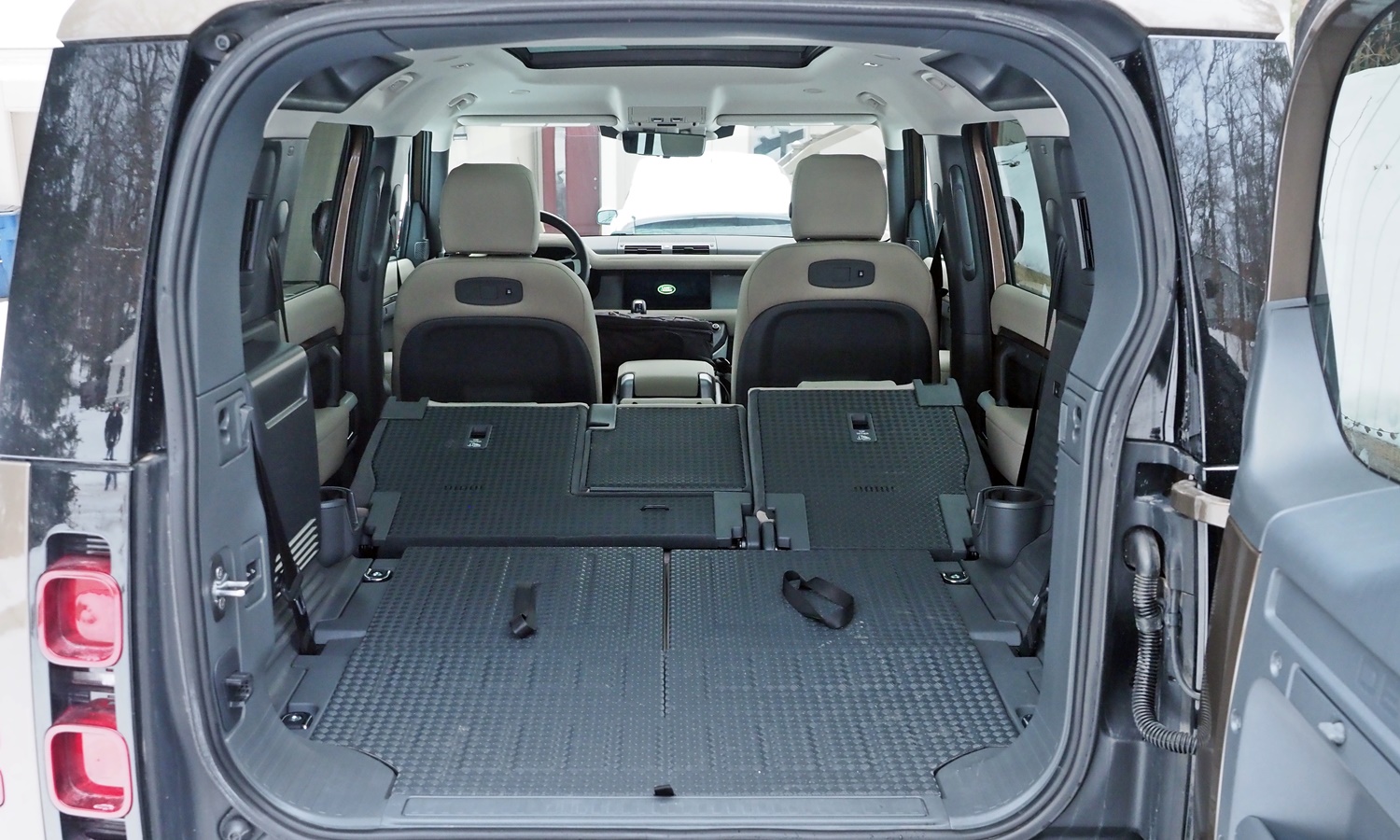
With the hard plastic floor (which feels a bit flimsy) your stuff will slide. Side-hinged door.
See more 2020 Land Rover Defender photos
Land Rover provided an insured vehicle for a week with a tank of gas. Jeep provided a vehicle at a regional media association event.











